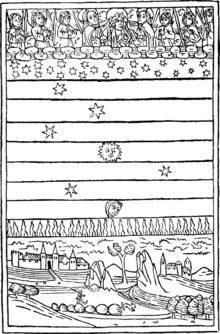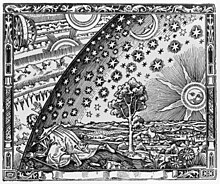체르마운트
Firmament성서 우주론에서, 굳은살은 신이 세상을 창조하는 동안 육지가 [1][2]나타날 수 있도록 원시 바다를 상부와 하부로 나누기 위해 만든 거대한 단단한 돔이다.이 개념은 이후 고전/중세의 천구 모델에 채택되었지만, 16세기와 17세기에 천문학의 발전과 함께 사라졌습니다.오늘날 그것은 "하늘" 또는 "천국"의 동의어로 남아있다.
어원학
영어로 "확실함"이라는 단어는 중세 영어의 창세기 및 엑소더스 이야기에 1250년 초에 기록되어 있다.그것은 나중에 제임스 왕 성경에 등장했어요.같은 단어가 불게이트([3]4세기)에서 사용된 라틴어 firmamentum(고체)에서 유래한 프랑스어와 독일어 성경 번역에서도 발견된다.This in turn is a calque of the Greek στερέωμᾰ (steréōma), also meaning a solid or firm structure (Greek στερεός = rigid), which appears in the Septuagint, the Greek translation made by Jewish scholars around 200 BCE.
이 단어들은 모두 성경의 히브리어 단어인 라크차(raq thesea)를 번역한다. רָקִ֫יעַ), used for example in Genesis 1.6, where it is contrasted with shamayim (שָׁמַיִם), translated as "heaven(s)" in Genesis 1.1. Rāqīaʿ derives from the root rqʿ (רָקַע), meaning "to beat or spread out thinly".[4][5]게르하르트 폰 라드의 설명:
Raqaa means는 단단하게 두들겨지고 찍힌 것을 의미합니다(페네키아어로 같은 어근의 단어는 "주석 접시!"를 의미합니다).rq concerns 동사의 의미는 하늘 창고를 단단하게 두드리는 것과 관련이 있다(Isa. 42.5; P.136.6).벌게이트는 라카다를 firmamentum으로 번역하는데, 그것이 최고의 표현으로 남아 있다.
--
역사
고대 히브리인들은 근동의 모든 고대 사람들과 마찬가지로 하늘은 태양, 달,[7] 행성, 별이 박힌 단단한 돔이라고 믿었다.기원전 4세기에서 3세기 경, 그리스인들은 하늘이 완벽해야 하고 구는 완벽한 기하학적 도형이라고 주장한 아리스토텔레스의 영향을 받아, 이것을 단단한 구로 둘러싸인 구형의 지구로 교환했다.이것은 고전과 중세 세계관에서의 지배적인 모델이 되었고, 코페르니쿠스가 태양을 시스템의 중심에 놓았을 때조차도 그는 별을 고정시키는 외부 구를 포함했습니다.1572년의 노바와 1577년의 혜성에 대한 티코 브라헤의 연구는 오블이 단단하고 부패할 수 없는 물질적 [8]물체로 존재한다는 생각에 대한 첫 번째 주요 도전이었고, 1584년 조르다노 브루노는 확고하지 않은 우주론을 제안했습니다: 별들이 실제로 행성계를 [9]가지고 있는 무한한 우주입니다.갈릴레오가 하늘을 조사하기 위해 망원경을 사용하기 시작한 후, 아리스토텔레스의 철학이 요구했던 것처럼, 하늘이 완벽하다고 주장하기가 어려워졌고, 1630년이 되자 고체 오브의 개념은 더 이상 [8]지배적이지 않았다.
「 」를 참조해 주세요.
인용문
- ^ 페닝턴 2007, 페이지 42
- ^ 링그렌 1990, 페이지 92
- ^ "Online Etymology Dictionary – Firmament". Archived from the original on 2012-10-18. Retrieved 2010-10-25.
- ^ Brown, Francis; Driver, S.R.; Briggs, Charles A. (1951). A Hebrew and English Lexicon of the Old Testament. Oxford University Press. 페이지 955.
- ^ "Lexicon Results Strong's H7549 – raqiya'". Blue Letter Bible. Blue Letter Bible. Archived from the original on 2011-11-03. Retrieved 2009-12-04.
- ^ 폰 라드 1961 페이지 53
- ^ Seely, Paul H. (1991). "The Firmament and the Water Above" (PDF). Westminster Theological Journal. 53: 227–40. Archived (PDF) from the original on 2009-03-05. Retrieved 2010-02-02.
- ^ a b 1996년 허가, 349페이지
- ^ Giordano Bruno, De l'infinito universo e mondi, 1584년.
참고 문헌
- Grant, Edward (1996). Planets, Stars, and Orbs: The Medieval Cosmos, 1200-1687. Cambridge University Press.
- Andrews, Tamra (2000). Dictionary of Nature Myths: Legends of the Earth, Sea, and Sky. Oxford University Press. ISBN 9780195136777. Archived from the original on 2020-11-06. Retrieved 2021-02-01.
- Bandstra, Barry L. (1999). Reading the Old Testament: An Introduction to the Hebrew Bible. Wadsworth. ISBN 0495391050. Archived from the original on 2021-02-01. Retrieved 2021-02-01.
- Berlin, Adele (2011). "Cosmology and creation". In Berlin, Adele; Grossman, Maxine (eds.). The Oxford Dictionary of the Jewish Religion. Oxford University Press. ISBN 9780199730049. Archived from the original on 2021-02-01. Retrieved 2021-02-01.
- Blenkinsopp, Joseph (2011). Creation, Un-Creation, Re-Creation: A Discursive Commentary on Genesis 1–11. T&T Clarke International. ISBN 9780567574558. Archived from the original on 2021-02-01. Retrieved 2021-02-01.
- Broadie, Sarah (1999). "Rational Theology". In Long, A.A. (ed.). The Cambridge Companion to Early Greek Philosophy. Cambridge University Press. ISBN 9780521446679. Archived from the original on 2021-02-01. Retrieved 2021-02-01.
- Bunnin, Nicholas; Yu, Jiyuan (2008). The Blackwell Dictionary of Western Philosophy. Blackwells. ISBN 9780470997215. Archived from the original on 2020-10-14. Retrieved 2021-02-01.
- Clifford, Richard J (2017). "Creatio ex Nihilo in the Old Testament/Hebrew Bible". In Anderson, Gary A.; Bockmuehl, Markus (eds.). Creation ex nihilo: Origins, Development, Contemporary Challenges. University of Notre Dame. ISBN 9780268102562. Archived from the original on 2021-02-01. Retrieved 2021-02-01.
- Couprie, Dirk L. (2011). Heaven and Earth in Ancient Greek Cosmology: From Thales to Heraclides Ponticus. Springer Science & Business Media. ISBN 9781441981165. Archived from the original on 2020-11-02. Retrieved 2021-02-01.
- Grunbaum, Adolf (2013). "Science and the Improbability of God". In Meister, Chad V.; Copan, Paul (eds.). The Routledge Companion to Philosophy of Religion. Routledge. ISBN 9780415782944. Archived from the original on 2020-07-26. Retrieved 2021-02-01.
- James, E.O. (1969). Creation and Cosmology: A Historical and Comparative Inquiry. Brill. ISBN 9789004378070. Archived from the original on 2020-10-30. Retrieved 2021-02-01.
- López-Ruiz, Carolina (2010). When the Gods Were Born: Greek Cosmogonies and the Near East. Harvard University Press. ISBN 9780674049468. Archived from the original on 2021-02-01. Retrieved 2021-02-01.
- Mabie, F.J (2008). "Chaos and Death". In Longman, Tremper; Enns, Peter (eds.). Dictionary of the Old Testament. InterVarsity Press. ISBN 9780830817832. Archived from the original on 2021-02-01. Retrieved 2021-02-01.
- May, Gerhard (2004). Creatio ex nihilo. T&T Clarke International. ISBN 9780567456229. Archived from the original on 2021-02-01. Retrieved 2021-02-01.
- Nebe, Gottfried (2002). "Creation in Paul's Theology". In Hoffman, Yair; Reventlow, Henning Graf (eds.). Creation in Jewish and Christian Tradition. Sheffield Academic Press. ISBN 9781841271620. Archived from the original on 2021-02-01. Retrieved 2021-02-01.
- Muller, Richard A. (2017). Dictionary of Latin and Greek Theological Terms. Baker Academic. ISBN 9781493412082. Archived from the original on 2021-02-01. Retrieved 2021-02-01.
- Pennington, Jonathan T. (2007). Heaven and earth in the Gospel of Matthew. Brill. ISBN 978-9004162051. Archived from the original on 2021-02-01. Retrieved 2021-02-01.
- Pruss, Alexander (2007). "Ex Nihilo Nihil Fit". In Campbell, Joseph Keim; O'Rourke, Michael; Silverstein, Harry (eds.). Causation and Explanation. MIT Press. ISBN 9780262033633. Archived from the original on 2021-02-01. Retrieved 2021-02-01.
- von Rad, Gerhard (1961). Genesis: A Commentary. London: SCM Press.
- Ringgren, Helmer (1990). "Yam". In Botterweck, G. Johannes; Ringgren, Helmer (eds.). Theological Dictionary of the Old Testament. Eerdmans. ISBN 9780802823304. Archived from the original on 2021-02-01. Retrieved 2021-02-01.
- Rubio, Gonzalez (2013). "Time Before Time: Primeval Narratives in Early Mesopotamian Literature". In Feliu, L.; Llop, J. (eds.). Time and History in the Ancient Near East: Proceedings of the 56th Recontre Assyriologique Internationale at Barcelona, 26–30 July 2010. Eisenbrauns. Archived from the original on 1 February 2021. Retrieved 1 February 2021.
- Waltke, Bruce K. (2011). An Old Testament Theology. Zondervan. ISBN 9780310863328. Archived from the original on 2021-02-01. Retrieved 2021-02-01.
- Walton, John H. (2006). Ancient Near Eastern Thought and the Old Testament: Introducing the Conceptual World of the Hebrew Bible. Baker Academic. ISBN 0-8010-2750-0. Archived from the original on 2021-02-01. Retrieved 2021-02-01.
- Walton, John H. (2015). The Lost World of Adam and Eve: Genesis 2-3 and the Human Origins Debate. InterVarsity Press. ISBN 9780830897711. Archived from the original on 2021-02-01. Retrieved 2021-02-01.
- Wasilewska, Ewa (2000). Creation Stories of the Middle East. Jessica Kingsley Publishers. ISBN 9781853026812. Archived from the original on 2020-11-03. Retrieved 2021-02-01.
- Wolfson, Harry Austryn (1976). The Philosophy of the Kalam. Harvard University Press. ISBN 9780674665804. Archived from the original on 2016-05-07. Retrieved 2021-02-01.
- Wolters, Albert M. (1994). "Creatio ex nihilo in Philo". In Helleman, Wendy (ed.). Hellenization Revisited: Shaping a Christian Response Within the Greco-Roman World. University Press of America. ISBN 9780819195449. Archived from the original on 2021-02-01. Retrieved 2021-02-01.






